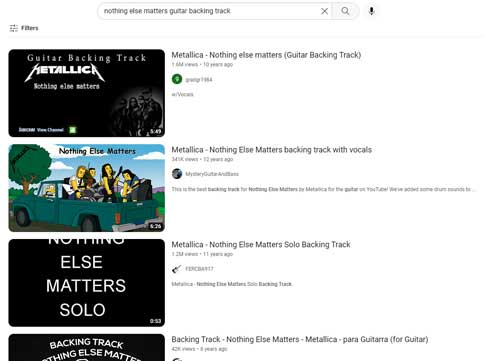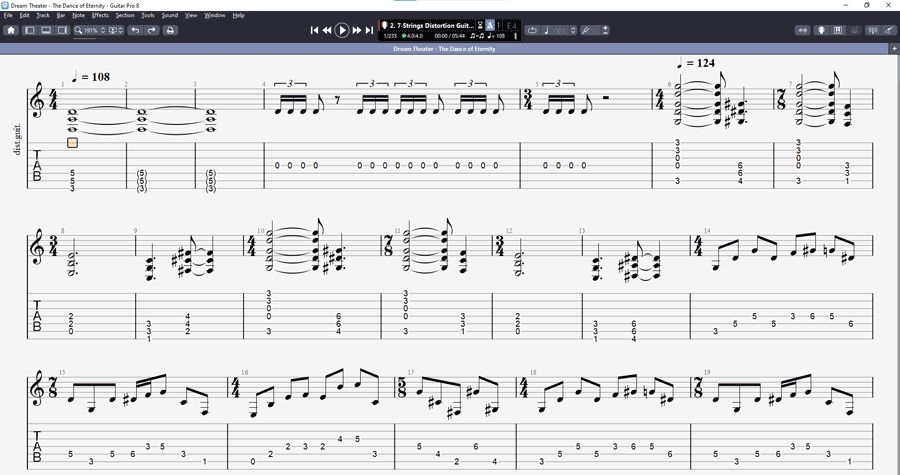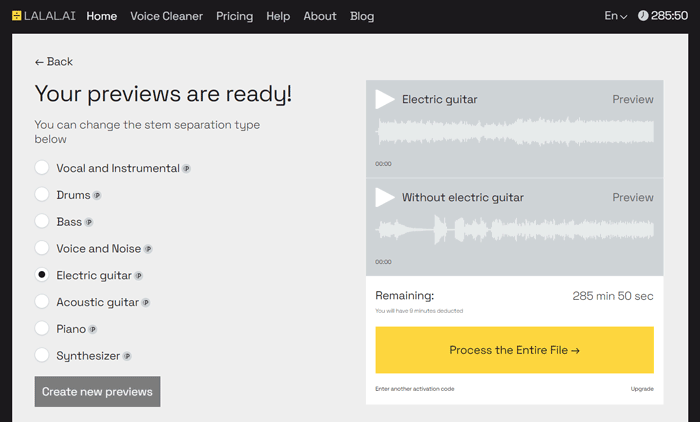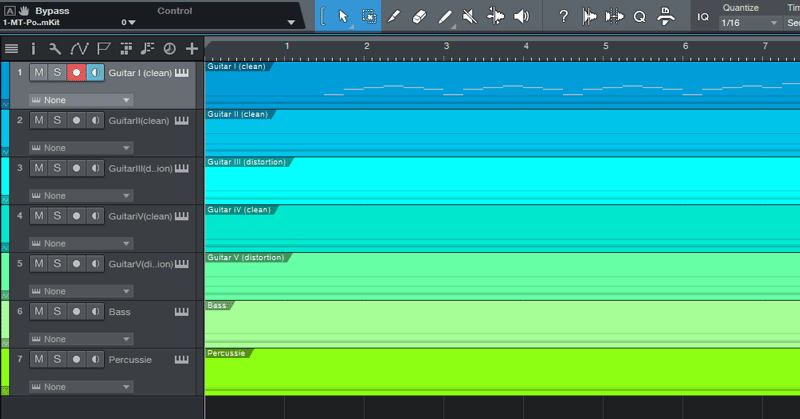Backing tracks are a great way to jam along with songs, add something else to your performances, or use as a practice tool.
In this guide, let’s look at how you can create backing tracks for existing or original songs.
I’ll share with you four methods you can use to create your own guitar backing tracks with step-by-step instructions and tips.
Method 1: YouTube
The quickest and easiest method that sometimes works well is to search for the song on YouTube with “backing track” or “guitar backing track” in your search.
Many guitarists have created guitar backing tracks for well-known songs and uploaded them to YouTube.
Some of these backing tracks were completely recorded by the uploader, some use filters to add vocal tracks to pre-recorded instruments, while others were created from the song’s actual stem files, which means they will sound exactly like the song with the guitar parts removed.
With a bit of luck, the song you may want to play with has one or more good-quality backing tracks ready to go.
For example, here are the current search results for “Nothing else matters guitar backing track“:

I counted 13 backing tracks, some with vocals and some without. Some of the backing tracks were created with the original song’s tracks and included the proper vocals, while others used tracks recorded by the uploader.
If you want a backing track for an existing song, it’s always a good idea to have a quick search on YouTube to see what is available.
Method 2: Guitar Pro Files
The next easiest method is to download the Guitar Pro file for the song you want to create a backing track for. Or if you want to create a backing track for an original song, you can create a Guitar Pro file for your song.
Guitar Pro (link to my review and tutorial) is a Guitar TAB and notation program that allows you to play along with the tracks.
If you’re learning a song, you can read the Guitar TAB (learn how to read Guitar TAB here) or Standard Notation (learn to read Standard Notation here) while jamming along with the song.

You can download countless Guitar Pro files at one of these Guitar TAB websites.
With Guitar Pro, you can mute different instrument tracks, which gives you an easy way to customize your backing tracks.
For example, you can mute all the guitar tracks and keep the rhythm guitar part during any solo sections.
Here’s an example of what the default instruments sound like in Guitar Pro:
This isn’t as good as a proper guitar backing track recorded with real instruments, but it’s a quick and easy way to create a backing track if you just want to jam with a song without hearing the guitar parts.
If you want to create a better-sounding backing track, you can take the Guitar Pro file and export it to a DAW to use with high-quality virtual instruments. This is explained in Method 4 below.
Another reason you might want to use Guitar Pro for your guitar backing tracks is the ability to easily change tunings or slow down/speed up the song without affecting pitch.
For example, if a song is normally played on a guitar tuned down a whole step to D Standard (learn about alternate tunings here), you can easily change the tuning to match your guitar in E Standard.
Learn more about Guitar Pro here.
Method 3: Remove Guitar From Audio Files
Over the years there have been many audio processing tools that attempt to remove vocals from tracks so people can create karaoke versions of songs.
In recent years, the quality of these tools has increased significantly to the point where it’s possible to isolate and remove individual instruments from a song.
We can now use these tools to create our own backing tracks from songs with sometimes flawless results.
LALAL.AI is one of the options that use AI to process and isolate and extract vocals, drums, bass, electric guitar, acoustic guitar, piano, and synths from a song.
This means you can upload a song and remove the guitar parts while keeping the vocals and other instruments in place.

In the above screenshot, you can see that I selected to remove the electric guitar from a song. You can then download the isolated guitar track as well as a track without the guitar.
Here is an example of the solo section from the song “Comfortably Numb” with the electric guitar parts removed:
This is a quick and easy way to create guitar backing tracks. It took about 5 minutes to upload the song, go through the steps, process the file, then download the backing track.
If you listen closely, you can just hear some bleed-through of electric guitar. While it’s not perfect, being able to easily create a backing track with the original song and vocals is a big improvement over jamming along with the normal song file.
As tools like this filter out instruments, the quality of the backing tracks you end up with will vary from song to song.
Some songs and styles of music can produce near-perfect backing tracks, while others will end up with artifacts and filtering coming through.
I’m currently working on a detailed review and tutorial of LALAL.AI, so subscribe to updates here to be notified when it is published.
Method 4: Virtual Instruments in a DAW
The fourth method is to create a backing track in a DAW using virtual or real instruments.
A DAW is a Digital Audio Workstation that gives you a wide range of tools to record, mix, and edit tracks to produce your own songs.
Find out all about DAWs here with tutorials for all of the recommended DAWs.
The great thing about DAWs is that you can install plugins to do anything from add effects and amp models to your recorded guitar tone, to add completely virtual instruments that sound completely realistic.
For example, here is a free plugin that adds a virtual drum kit you can program to play anything you want:

Here’s an example of what the above plugin sounds like:
When you consider that it only took me a minute to add the plugin and set up the beat (the plugin includes a massive library of grooves and fills), this is a great tool to have as a guitarist.
I’ve created a full tutorial on creating drum tracks in DAWs so check it out to learn how to create and program your own drum tracks.
As well as drums, you can download plugins for essentially any other instrument you can think of including guitar, bass, drums, synth, orchestral, piano, choir, etc.
If you’ve never looked into sample-based plugins before, you might be shocked by how realistic they can sound.
You can build full backing tracks (except vocals) using nothing but virtual instruments in a DAW that will sound just as good or better than real recorded instruments.
Step 1: Import MIDI
The easiest way to create virtual instrument tracks in a DAW is to start with a MIDI file for the song.
If you have the Guitar Pro file for the song, simply select File > Export > MIDI.
If you don’t have Guitar Pro, search online for the song + “MIDI”. This method can be hit or miss, which is why I recommend using Guitar Pro.
Import the MIDI file into your DAW and you’ll see all the different instrument tracks:

You can mute or delete any tracks you don’t want to include in your backing track.
If your DAW doesn’t automatically adjust the project tempo to match the MIDI tempo, you will need to manually change it.
Step 2: Load Virtual Instrument Plugins
Now you can apply any virtual instrument plugins you want to each track you want to include in your backing track.
In this example, I’ve added a free drum plugin to the drum track and using IK Multimedia’s MODO Bass 2 for the virtual bass track:

As mentioned earlier, check out my guide to Guitar Plugins to learn more about plugins in general as well as plugins for virtual instruments.
In most DAWs, all you need to do is drag and drop the plugin from the plugin library onto the track.
Then you can go into the plugin to change settings and set up the sound you want.
For example, in the MODO Bass 2 plugin, you can change between different types of basses, choose whether the notes are played with a pick, fingers, or slapped, different pickups, strings, etc.
Step 3: Mix and Export Backing Track
Once you set up the virtual instrument tracks, you can adjust the levels of each instrument and export your backing track.
Here’s what my quick drum and bass example sounds like after 3 minutes worth of work importing the MIDI file and setting up the plugins:
The great thing about creating your own backing track in a DAW is that you can easily tweak the instruments and change or add/remove parts as you like.
For example, I don’t like how the drums currently use closed hi-hats. So with a simple edit to the drum track, I can change it to use open hi-hats:
Once you get used to setting up and editing virtual instruments in a DAW, you’ll quickly see how useful they are to have as guitarists. Being able to set up drums, bass, piano, synths, orchestral instruments and more with realistic sounds is easier than ever today.
Check out my Guide to Plugins for Guitar here to try out some free and paid plugins. Some of the plugins covered in the guide focus on guitar amps and effects, while others look at virtual instruments you can use in your backing tracks.
Useful Guides
Here are some guides to help you get started recording guitar and jamming with backing tracks:
- Recording Guitar at Home
- Ultimate Guide to Guitar Plugins
- Best DAWs for Guitar with Tutorials
- Recording Your First Song Tutorial
- How to Memorize the Fretboard
